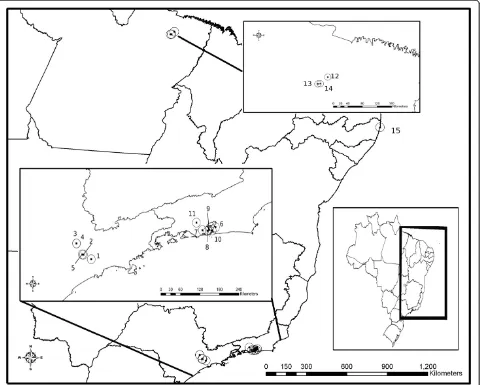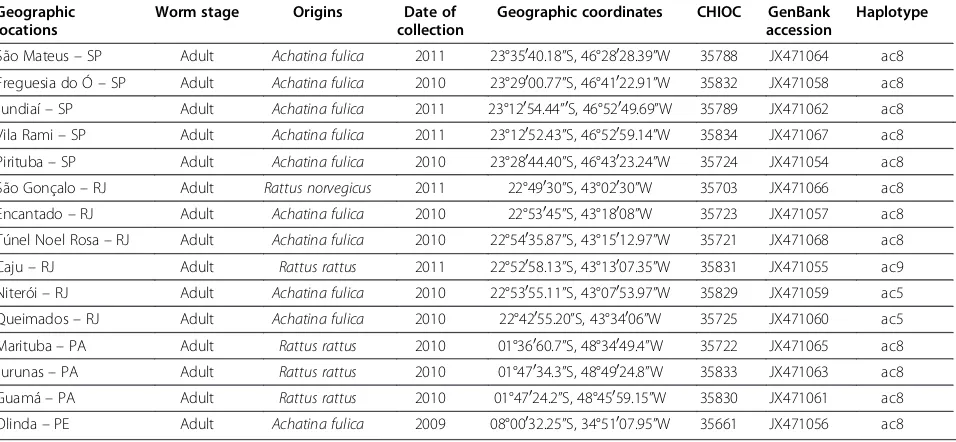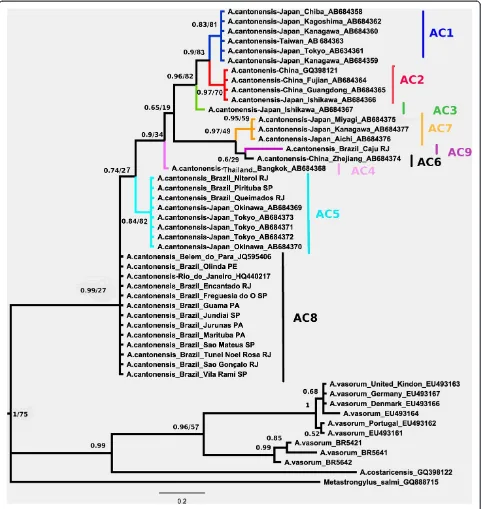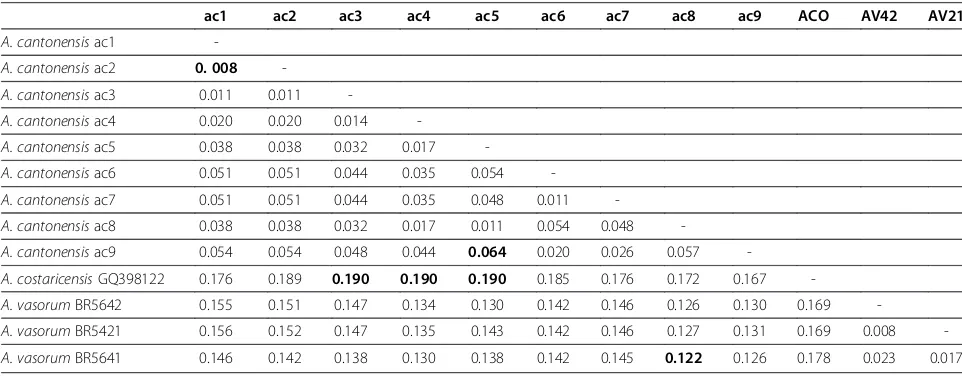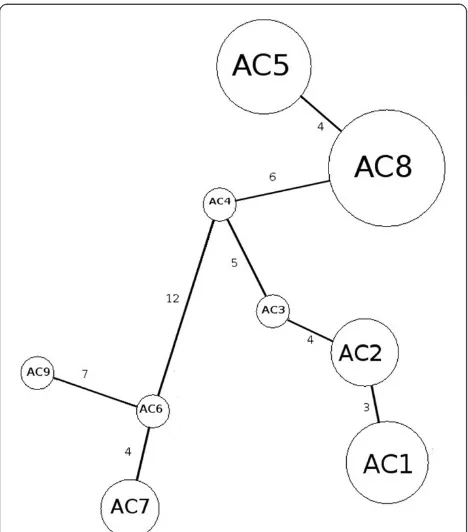R E S E A R C H
Open Access
Phylogenetic relationship of the Brazilian isolates
of the rat lungworm
Angiostrongylus cantonensis
(Nematoda: Metastrongylidae) employing
mitochondrial COI gene sequence data
Tainá CC Monte
1, Raquel O Simões
1, Ana Paula M Oliveira
2, Clodoaldo F Novaes
3, Silvana C Thiengo
2,
Alexandre J Silva
4, Pedro C Estrela
1and Arnaldo Maldonado Júnior
1*Abstract
Background:The rat lungwormAngiostrongylus cantonensiscan cause eosinophilic meningoencephalitis in humans. This nematode’s main definitive hosts are rodents and its intermediate hosts are snails. This parasite was first described in China and currently is dispersed across several Pacific islands, Asia, Australia, Africa, some Caribbean islands and most recently in the Americas. Here, we report the genetic variability amongA. cantonensis isolates from different geographical locations in Brazil using mitochondrial cytochrome c oxidase subunit I (COI) gene sequences.
Methods:The isolates ofA. cantonensiswere obtained from distinct geographical locations of Brazil. Genomic DNAs were extracted, amplified by polymerase reaction, purified and sequenced. A partial sequence of COI gene was determined to assess their phylogenetic relationship.
Results:The sequences ofA. cantonensiswere monophyletic. We identified a distinct clade that included all isolates ofA. cantonensisfrom Brazil and Asia based on eight distinct haplotypes (ac1, ac2, ac3, ac4, ac5, ac6, ac7 and ac8) from a previous study. Interestingly, the Brazilian haplotype ac5 is clustered with isolates from Japan, and the Brazilian haplotype ac8 from Rio de Janeiro, São Paulo, Pará and Pernambuco states formed a distinct clade. There is a divergent Brazilian haplotype, which we named ac9, closely related to Chinese haplotype ac6 and Japanese haplotype ac7.
Conclusion:The genetic variation observed among Brazilian isolates supports the hypothesis that the appearance ofA. cantonensisin Brazil is likely a result of multiple introductions of parasite-carrying rats, transported on ships due to active commerce with Africa and Asia during the European colonization period. The rapid spread of the intermediate host,Achatina fulica, also seems to have contributed to the dispersion of this parasite and the infection of the definitive host in different Brazilian regions.
Keywords:Rattus norvegicus,Achatina fulica, Eosinophilic meningoencephalitis, Molecular phylogeny, Cytochrome c oxidase subunit I, Brazil
* Correspondence:maldonad@ioc.fiocruz.br
1Laboratório de Biologia e Parasitologia de Mamíferos Silvestres
Reservatórios, Instituto Oswaldo Cruz, Avenida Brasil 4365, Manguinhos 21040-360 Rio de Janeiro, Brazil
Full list of author information is available at the end of the article
Background
Angiostrongylus cantonensis(Chen, 1935) is a nematode that lives in the right ventricle and pulmonary arteries of rats. Rodents such asRattus rattusandRattus
norvegi-cusare considered the most important definitive hosts [1]. This nematode is the most common cause of eosinophilic meningoencephalitis in humans [2,3]. The rat lung-worm was first described in China infecting these same rodents. Currently, the nematode is dispersed across several Pacific islands, Asia, Australia, Africa, some Caribbean islands and most recently in the Americas [4-6]. The transmission of this nematode has been linked to dispersal of invasive organisms [7]. In particu-lar, the introduction of Achatina fulica in Brazil and
Pomacea canaliculata (Lamarck, 1822) in China are examples of the importance of exotic snails in the spread of this helminthiasis [5,8,9]. Similarly, the nema-tode may haveA. fulicaas one of its main intermediate hosts in Brazil [10,11]. Currently, this mollusk is experiencing the explosive phase of invasion, since it has been found in 25 of the 26 Brazilian states and in the Federal District [12]. Humans are accidentally infected by eating raw and undercooked snails that con-tain the third stage larvae (L3) [13]. The infection can also occur by eating animals that act as paratenic hosts, such as shrimps, crabs, lizards, frogs and terrestrial pla-narians or through vegetables contaminated by the mucus of infected snails [4]. More recently, the presence of A. fulicanaturally infected by L3 larvae of A.
canto-nensis in different states of Brazil, such as Espírito Santo, São Paulo, Pernambuco and Santa Catarina, was confirmed by experimental infection in R. norvegicus [14]. Cases of human eosinophilic meningoencephalitis have also been reported in the states of Espírito Santo, Pernambuco and São Paulo [5,15,16].
The morphological heterogeneity, such as bursal rays characteristics among Brazilian isolates of A. cantonensis, was reported by Maldonado et al. (2010) [14], who have suggested this occurred as a result of distinct entry of the parasite into the country. Recent studies using sequencing of the mitochondrial protein-coding gene cytochrome c oxidase subunit I (COI) to distin-guish A. cantonensis isolates confirmed the presence of three geographical isolates in Asia [17]. Subsequently, Simões et al. (2011) [18], using COI data, observed that A. cantonensis from Rio de Janeiro, Brazil yield a single haplotype, which formed a clade with low ge-netic distance to the Chinese isolates. Interestingly, Tokiwa et al. (2012) [7], analyzing a great number of geographical isolates from the Asian continent, pro-posed that Rio de Janeiro isolates are more similar to
A. cantonensis isolated from Japan.
In the present study, we analyzed A. cantonensis worms from Brazil using the COI gene to assess the
genetic variability of different geographical isolates as well as to determine the phylogenetic relationship among the Brazilian isolates.
Methods
Geographical isolates
The isolates of A. cantonensis were obtained from dis-tinct geographical locations in Brazil (Figure 1), after ex-perimental infection of R. norvegicus with L3 larvae recovered from A. fulica naturally infected obtained from the National Reference Laboratory of Medical Malacology, Oswaldo Cruz Foundation, or through na-turally infected R. norvegicus and R. rattus (Table 1). Collection permits for rodents were obtained from the animal use ethics committee of Oswaldo Cruz Founda-tion (FIOCRUZ) (CEUA no. LW 24/10).
Experimental infection
The snails were individually minced and digested in a 0.7% HCl solution for 6 h. The digested samples were then placed in a Baermann apparatus and allowed to sediment overnight. The L3 nematode larvae obtained from digested snails were administered orally to 3-month-old R. norvegicus (Wistar strain) rats (100 L3/ animal). Thirty-five days after administration of the lar-vae, the rodents were euthanized using a CO2 chamber and adult worms were collected from the pulmonary ar-teries, washed in physiologic solution and fixed in 70% ethanol or frozen for molecular analysis. The specimens from each isolate were cleared and mounted as tempo-rary slides in lactophenol solution and examined under a light microscope. Taxonomic identification of the nema-todes was based on morphological parameters obtained from previous studies [12,14].
Molecular and phylogenetic analysis
Genomic DNA samples were extracted using the Qiagen QIAamp DNA Mini Kit, according to the manufacturer’s protocol. The extracted DNA was stored at 4°C until use. The DNA amplification by polymerase reaction was conducted using the previously described primers COI_F 5’ TTTTTTGGGCATCCTGAGGTTTAT 3’and COI_R 5’TAAAGAAAGAACATAATGAAAATG 3’for a partial region of the COI gene [19,20]. The reaction mixture was prepared in a total volume of 50μL containing 16.2 μL of water, 5 μL of 10 x PCR buffer (Tris-HCl, KCl), 2.5μL of MgCl2 (2.5 mM), 5 μL of dNTP mix (10 mM each), 10 μL of each primer (0.2 mM), 0.3 μL of Taq DNA polymerase (1.5U) and 1 μL of sample DNA. The thermocycler was programmed to incubate the samples for 5 min at 94°C, followed by 40 cycles at 94°C for 30s, 55°C for 30s, 72°C for 1 min and final extension at 72°C for 5 min. The reaction products were separated by elec-trophoresis on 1.0% agarose gel, stained with ethidium
Monteet al. Parasites & Vectors2012,5:248 Page 2 of 9
bromide and visualized under ultraviolet light. Ampli-fied products were puriAmpli-fied using the QIAquick PCR Purification Kit (Qiagen). Sequencing reactions were performed using an ABI PrismDyeTerminator Cycle Sequencing Core Kit (Applied Biosystems, USA) as described by Genomic Platform-DNA Sequencing (PDTIS/FIOCRUZ). A partial sequence of the COI gene was determined to assess their phylogenetic relation-ship. All sequences determined in this study have been deposited in the GenBank database: six sequences ofA.
cantonensis from the state of Rio de Janeiro; five sequences from the state of São Paulo; three sequences from the state of Pará and one sequence from the state of Pernambuco (Table 1).
Alignment and editing of sequences were performed using Clustal W inMEGAversion 5 [21,22]. The nucleo-tide variation and p-distance were calculated using the
[image:3.595.59.539.90.475.2]between purines and pyrimidines as equal. As there is no analytical form to estimate HKY+G distances, we used TrN93 model [27]. The posterior probabilities (BPP) were estimated using Markov chain Monte Carlo (MCMC) analysis, which was run for 10,000,000 generations with data sampling every 500 generations, discarding the first 1000 sampled trees as burn-in. A BLAST search (http:// blast.ncbi.nlm.nih.gov/Blast.cgi) was performed to clarify any similarities with the sequences obtained and pre-viously published sequences. COI sequences from
Angios-trongylusspp. were obtained from the GenBank as follows:
A. cantonensis from Japan, China, Taiwan, Thailand and Brazil; A. vasorum from the UK and A. costaricensis. Sequences of Metastrongylus salmi were used as out-group. Haplotypes for A. vasorum isolates from Brazil (A. vasorum 5421, 5641, and 5642) were reconstructed from published information [20] (Figure 2).
Results
The COI partial sequences ofA. cantonensiswere deter-mined from 15 geographic isolates from Brazil and pre-sented a length varying from 440 to 460 bp. We aligned 360 bp of COI gene to compare it with other sequences previously available in the GenBank database. The sequences analyzed revealed that in 338 bp (93.9%) the positions of the nucleotides were monomorphic or in-variable, while 22 sites (6.1%) were in-variable, of which four sites were parsimony-informative, and the amino acid sequences did not reveal any variability in 120 encoded amino acids, generating three different haplotypes of COI
(ac5, ac8 and ac9) based on eight distinct haplotypes, as mencioned by Tokiwaet al.(2012) [7].
The evolutionary parameters kappa, pi(A), pi(C), pi (G), pi(T) and alpha were estimated through MCMC sampling with lower and upper limits and presented the following values of average and variance respect-ively: kappa 7.7 / 6.0; pi(A) 0.20 / 0.0002; pi(C) 0.05 / 0.00008; pi(G) 0.30 / 0.0004; pi(T) 0.45 / 0.0006 and alpha 0.15 / 0.0002.
The phylogenetic trees inferred using the two methods showed a similar topology but with some minor differences in six nodes involving A. vasorum and A.
cantonensisfrom Túnel Noel Rosa (Rio de Janeiro). The Bayesian tree, presented with a condensed root and pos-terior probabilities at nodes (BPP) and bootstrap values for NJ, can be found in Figure 2 and showed higher nodal support valued than the NJ tree rooted on M.
salmi based on TrN93 distances (Additional file 1: Figure S2). The bootstrap values of the branches with different topologies mentioned above, were not included in Bayesian tree. The Angiostrongylus species were grouped into two major clades. The sequences of A.
[image:4.595.59.537.112.333.2]cantonensis were monophyletic. The clade correspond-ing to A. cantonensiswas supported with low bootstrap values of 27% for NJ and high posterior probability values of 0.99 for BI. Within A. cantonensis, the geo-graphical isolates corresponding to Brazilian haplotypes ac5 and ac8 were the first to branch, with low bootstrap values of 27% for NJ and posterior probability values of 0.74 for BI. The Brazilian haplotype ac9 was clustered in a distinct clade with Chinese haplotype ac6 and Japanese Table 1Angiostrongylus cantonensissamples isolated from São Paulo (SP), Rio de Janeiro (RJ), Pará (PA) and
Pernambuco (PE) used in the present study
Geographic locations
Worm stage Origins Date of
collection
Geographic coordinates CHIOC GenBank accession
Haplotype
São Mateus–SP Adult Achatina fulica 2011 23°35040.18”S, 46°28028.39”W 35788 JX471064 ac8
Freguesia do Ó–SP Adult Achatina fulica 2010 23°29000.77”S, 46°41022.91”W 35832 JX471058 ac8
Jundiaí–SP Adult Achatina fulica 2011 23°12054.44”0S, 46°52049.69”W 35789 JX471062 ac8
Vila Rami–SP Adult Achatina fulica 2011 23°12052.43”S, 46°52059.14”W 35834 JX471067 ac8
Pirituba–SP Adult Achatina fulica 2010 23°28044.40”S, 46°43023.24”W 35724 JX471054 ac8
São Gonçalo–RJ Adult Rattus norvegicus 2011 22°49030”S, 43°02030”W 35703 JX471066 ac8
Encantado–RJ Adult Achatina fulica 2010 22°53045”S, 43°18008”W 35723 JX471057 ac8
Túnel Noel Rosa–RJ Adult Achatina fulica 2010 22°54035.87”S, 43°15012.97”W 35721 JX471068 ac8
Caju–RJ Adult Rattus rattus 2011 22°52058.13”S, 43°13007.35”W 35831 JX471055 ac9
Niterói–RJ Adult Achatina fulica 2010 22°53055.11”S, 43°07053.97”W 35829 JX471059 ac5
Queimados–RJ Adult Achatina fulica 2010 22°42055.20”S, 43°34006”W 35725 JX471060 ac5
Marituba–PA Adult Rattus rattus 2010 01°36060.7”S, 48°34049.4”W 35722 JX471065 ac8
Jurunas–PA Adult Rattus rattus 2010 01°47034.3”S, 48°49024.8”W 35833 JX471063 ac8
Guamá–PA Adult Rattus rattus 2010 01°47024.2”S, 48°45059.15”W 35830 JX471061 ac8
Olinda–PE Adult Achatina fulica 2009 08°00032.25”S, 34°51007.95”W 35661 JX471056 ac8
Monteet al. Parasites & Vectors2012,5:248 Page 4 of 9
haplotype ac7, presenting bootstrap values of 49% for NJ and high posterior probability values of 0.97 for BI.
Only oneA. cantonensisisolate, Caju from the state of Rio de Janeiro, named haplotype ac9, formed a clade with haplotype ac6 from China (Zhejiang) and with haplotype ac7 from Japan (Miyagi, Kanagawa and Aichi). The isolates from Queimados and Niterói (state of Rio de Janeiro) and Pirituba (state of São Paulo) constituted
[image:5.595.58.539.89.598.2]JQ595406]; and Northeast region: Olinda (state of Per-nambuco), forming a distinct clade.
The closely related species had interspecificp-distance values, ranging from 12.2% (between A. cantonensisand
A. vasorum) to 19.0% (between A. cantonensis and A.
costaricensis). Intraspecific distance values among A.
[image:6.595.56.537.546.734.2]cantonensis ranged from 0.8% (between haplotypes ac1 and ac2) to 6.4% (between haplotypes ac5 and ac9) (Table 2).
The nucleotide variation between the clade that includes haplotypes ac5 and ac8 consisted of four muta-tional steps, while the mutamuta-tional steps between clades containing haplotype ac9 were 21 and 19 from haplotype ac5 and ac8, respectively. In addition, the mutational steps between haplotype ac9 and haplotypes ac6 and ac7 were seven and nine, respectively (Table 3 and Figure 3).
Discussion
In the present study, Brazilian isolates ofA. cantonensis were analyzed using mitochondrial COI gene sequences. This allowed evaluation of variability in A. cantonensis isolates from different geographical locations in Brazil. All sequences from Brazil were monophyletic with sequences from Asia. Tokiwa et al. (2012) [7], distin-guished eight different haplotypes, named ac1 to ac8. Most sequences from Brazilian samples were either ac5 or ac8. Moreover, we described a new haplotype named ac9, monophyletic with Chinese haplotype ac6.
The intraspecific variation observed among the Brazil-ian isolates ranged from 0.8% to 6.4%. These values are in agreement with the findings of Blouin (2002) [28], which showed that the level of mtDNA sequence va-riation among nematode individuals of the same species is lower than 10%.
The data observed in this study showed that the A.
cantonensisisolate from Caju (state of Rio de Janeiro) is restricted to the port area and could have entered the country through trade from Asia. The factor that might have prevented dispersal of haplotype ac9 to other places in the country is the absence of the main intermediate host,A. fulica, at the site where the rats were trapped.
Similarly, the Brazilian isolates from Pirituba (state of São Paulo), Queimados and Niterói (state of Rio de Janeiro), which correspond to haplotype ac5 from Japan, are believed to have entered through Rio de Janeiro or São Paulo also from the Asian continent. This hypoth-esis is also considered for the most abundant Brazilian haplotype (ac8), showing the possible spread from the arrival area to the Southeast, Northeast and North regions, probably through the giant African snail, A.
fulica.
Likewise, Araujo (1967) [29] showed in a study on hel-minth fauna inRattus norvegicusin the city of São Paulo that all rats captured were parasitized by 1 to 11 species of helminths. Interestingly, the helminth fauna lacked species of the genus Angiostrongylus. Moreover, Pessôa and Martins (1982) [30] reported that J.E. Alicata did not find A. cantonensisinfection in rodents collected in the Brazilian state of Bahia, suggesting the recent intro-duction of the parasite in the country.
A. fulica has been considered a snail pest in tropical and subtropical regions where it has been introduced. In Brazil, this exotic snail was introduced in the state of Paraná in the 1980s, probably brought from Indonesia for commercial purposes that were not successful (escar-got farming). The high reproductive capacity and the tendency for people to release snails into the wild are the probable reasons for the rapid invasion of this spe-cies [8,11]. This snail is currently found in most
Table 2p-distance values of haplotypes ofAngiostrongylus cantonensis,Angiostrongylus costaricensisand Angiostrongylus vasorumbased on mitochondrial COI gene
ac1 ac2 ac3 ac4 ac5 ac6 ac7 ac8 ac9 ACO AV42 AV21
A. cantonensisac1
-A. cantonensisac2 0. 008
-A. cantonensisac3 0.011 0.011
-A. cantonensisac4 0.020 0.020 0.014
-A. cantonensisac5 0.038 0.038 0.032 0.017
-A. cantonensisac6 0.051 0.051 0.044 0.035 0.054
-A. cantonensisac7 0.051 0.051 0.044 0.035 0.048 0.011
-A. cantonensisac8 0.038 0.038 0.032 0.017 0.011 0.054 0.048
-A. cantonensisac9 0.054 0.054 0.048 0.044 0.064 0.020 0.026 0.057
-A. costaricensisGQ398122 0.176 0.189 0.190 0.190 0.190 0.185 0.176 0.172 0.167
-A. vasorumBR5642 0.155 0.151 0.147 0.134 0.130 0.142 0.146 0.126 0.130 0.169
-A. vasorumBR5421 0.156 0.152 0.147 0.135 0.143 0.142 0.146 0.127 0.131 0.169 0.008
-A. vasorumBR5641 0.146 0.142 0.138 0.130 0.138 0.142 0.145 0.122 0.126 0.178 0.023 0.017
Monteet al. Parasites & Vectors2012,5:248 Page 6 of 9
Table 3 Variable nucleotide positions within the mitochondrial COI gene from different haplotypes ofAngiostrongylus cantonensis
Nucleotide position
022 025 031 034 073 076 100 109 118 130 136 160 169 181 187 193 211 229 232 235 244 268 280 289 292 295 298 301 304 310 313 358
Halplotypes
ac1 A G A A A A T T T G G G A T G G G A G A A T A T T G A C G A G A
ac2 . . . A . . . C . . . G . . . .
ac3 . . . G . . . A . . . C . . . T . . . .
ac4 . . G G . G . . . . A . . . A . . . G . . T . . . .
ac5 . . G G . G . C C . A . . . A G . . . . G . G . G T A . . .
ac6 G T G G G . A . . . A . G C . A A . A G . . . . G A . T . . . G
ac7 G T G G G . A . . A A . G . . A A . A . . . G . G A . T . . . G
ac8 . . G G . G . . C . A A . . . . A G . . . . G . G . G T . G . .
ac9 G T G G G . A . . . A . G . T A A . A G G . . . T . G A G
Parasites
&
Vectors
2012,
5
:248
Page
7
o
f
9
vectors.co
m/content/5/1
Brazilian states. Factors such as its voracious feeding habits contribute to the extermination of the native snail fauna, reducing the available resources and increasing competition for physical space. The absence of natural pathogens also contributes to the high dispersion of these snails [31].
The increased presence ofA. cantonensisin the coun-try is likely a result of the rapid spread of its interme-diate host,A. fulica, contributing to the dispersion of this parasite and infection of the definitive host [12]. This phenomenon is described as one of the primary causes of the spread of eosinophilic meningoencephalitis [14].
The genetic variation observed among Brazilian iso-lates supports the hypothesis that the appearance of A.
cantonensisin Brazil is a result of multiple introductions of parasite-carrying rats and the snails that act as inter-mediate hosts. These were likely transported on ships due to trade with Africa and Asia during the period of European colonization [8,14] and dispersed via human transport, becoming endemic in port areas [7]. At the present moment a phylogeographic study of A.
cantonensis is essential to locate the geographical origin of these introductions, especially of haplotypes ac8 and ac9.
Conclusions
In summary, we studied the molecular variation of A.
cantonensisisolates from different geographical locations
in Brazil based on COI DNA sequences. This study showed that four Brazilian isolates are clustered with isolates from Japan, China and Thailand (haplotypes ac5 and ac9), and 11 Brazilian isolates form a distinct clade (haplotype ac8). In addition, haplotype ac9 represent a newA. cantonensis haplotype. The COI gene appears as a good marker for differentiating geographical isolates of
A. cantonensis. The phylogenetic features of this nema-tode help to understand how phylogeography can in-fluence the transmission dynamics of this parasite.
Additional file
Additional file 1:Figure S2.Neighbor-joining tree using 360 bp of mitochondrial COI gene.
Abbreviations
COI: Cytochrome c oxidase subunit I; L3: Third stage larvae; PDTIS: Genomic Platform-DNA Sequencing; NJ: Neighbor-joining; BI: Bayesian inference; BIC: Bayesian information criterion; AIC: Akaike information criterion; AICc: Corrected Akaike information criterion; TrN+G: Tamura-Nei model with Gamma distributed; HKY+G: Hasegawa-Kishino-Yano model with Gamma distributed; BPP: Posterior probabilities; MCMC: Markov chain Monte Carlo.
Competing interests
The authors declare that they have no competing interests.
Authors’contributions
TCCM participated in the study design, carried out laboratory experiments, participated in data analysis and participated in drafting the manuscript. ROS participated in the study design and participated in drafting the manuscript. APMO participated in the laboratory experiments. SCT participated in the study design and drafting the manuscript. CFN participated in the field work. AJS participated in the study design and drafting the manuscript. PCE participated in the study design, participated in data analysis and
participated in drafting the manuscript. AMJ participated in the study design, carried out laboratory experiments, participated in data analysis and participated in drafting the manuscript. All authors read and approved the final version of the manuscript.
Authors’information
Arnaldo Maldonado Júnior has a fellowship from the National Council for Scientific and Technological Development (CNPq).
Acknowledgements
We are grateful to Oswaldo Cruz Institute/FIOCRUZ, CAPES (Program of Basic Parasitology–grant 3031/2011) and CNPq, which supported this work and also thank the Genomic Platform-DNA Sequencing (PDTIS/FIOCRUZ). PCE was funded by CNPq-PDJ-FIOCRUZ grant 500091/2012-2. We also thank Franklyn Enrique Samudio Acosta for valuable suggestions and Nilson J Melo, Gerônimo N Costa and Jorge M Silva for technical support.
Author details
1Laboratório de Biologia e Parasitologia de Mamíferos Silvestres
Reservatórios, Instituto Oswaldo Cruz, Avenida Brasil 4365, Manguinhos 21040-360 Rio de Janeiro, Brazil.2Laboratório de Referência Nacional em Malacologia Médica, Instituto Oswaldo Cruz, Avenida Brasil 4365,
Manguinhos 21040-360 Rio de Janeiro, Brazil.3Secretaria de Saúde do Estado do Rio de Janeiro, Rua México 128, Centro 20031-142 Rio de Janeiro, Brazil. 4Division of Parasitic Diseases and Malaria, Centers for Disease Control and
Prevention, Center for Global Health, 1600 Clifton Road, Atlanta, GA 30333, USA.
[image:8.595.57.291.88.354.2]Received: 18 September 2012 Accepted: 27 October 2012 Published: 6 November 2012
Figure 3Haplotype network in the form of a minimum spanning tree based on partial COI gene sequence.
Monteet al. Parasites & Vectors2012,5:248 Page 8 of 9
References
1. Lunn JA, Lee R, Smaller J, Mackay BM, King T, Hunt GB, Martin P, Krockenberger MB, Spielman D, Malik R:Twenty two cases of canine neural angiostrongylosis in eastern Australia (2002-2005) and a review of the literature.Parasit Vectors2012,70:1–18.
2. Graeff-Teixeira C, Silva ACA, Yoshimura K:Update on eosinophilic meningoencephalitis and its clinical relevance.Clin Microbiol Rev2009, 22:322–348.
3. Chen CY, Kuo CC, Lo CP, Huang MY, Wang YM, Wang WY:Eosinophilic meningoencephalitis caused byAngiostrongylus cantonensis.QJM2011. doi:10.1093/qjmed/hcr261.
4. Foronda P, Lopez-Gonzales M, Miquel J, Torres J, Segovia M, Abreu-Costa N, Casanova JC, Valladares B, Mas-Coma S, Bargues MD, Feliu C:Finding of Parastrongylus cantonensis(chen,1935) inRattus rattusin tenerife, Canary Islands (Spain).Acta Trop2010,114:123–127.
5. Maldonado AJ, Simões R, Thiengo S:Angiostrongyliasis in the Americas. InZoonosis. Volume 1. 1st edition. Edited by Morales-Lorenzo J.: InTech; 2012:303–320. doi:10.5572/2125.
6. Morassutti AL, Graeff-Teixeira C:Interface molecules ofAngiostrongylus cantonensis: their role in parasite survival and modulation of host defenses.Int J Inflam2012,2012:1–6.
7. Tokiwa T, Harunari T, Tanikawa T, Komatsu N, Koizumi N, Tung K-C, Suzuki J, Kadosaka T, Takada N, Kumagai T, Akao N, Ohta N:Phylogenetic relationships of rat lungworm,Angiostrongylus cantonensis, isolated from different geographical regions revealed widespread multiple lineages.
Parasitol Int2012,61:431–436.
8. Thiengo S, Faraco F, Salgado N, Cowie R, Fernandez M:Rapid spread of an invasive snail in Soth America: the giant African snail, Achatina fulica, in Brasil.Biol Invasions2007,9:693–702.
9. Lv S, Zhang Y, Steinmann P, Yang G-J, Yank K, Zhou X-N, Utzinger J:The emergence of angiostrongyliasis in the People’s Republic of China: the interplay between invasive snails, climate change and transmission dynamics.Freshwater Biol2011,56:717–734.
10. Graeff-Teixeira C:Expansion ofAchatina fulicain Brazil and potential increased risk for angiostrongyliasis.Trans R Soc Trop Med Hyg2007, 101:743–744.
11. Zanol J, Fernandez MA, Oliveira APM, Russo CAM, Thiengo SC:O caramujo exótico invasorAchatina fulica(Stylommatophora, Mollusca) no Estado do Rio de Janeiro (Brasil): situação atual.Biota Neotrop2010,10:447–451. 12. Thiengo SC, Maldonado A, Mota EM, Torres EJ, Caldeira R, Carvalho OS,
Oliveira AP, Simões RO, Fernandez MA, Lanfredi RM:The giant African snail Achatina fulicaas natural intermediate host ofAngiostrongylus cantonensisin Pernambuco, northeast Brazil.Acta Trop2010,115:194–199. 13. Martin-Alonso A, Foronda P, Quispe-Ricalde MA, Feliu C, Valladares B:
Seroprevalence ofAngiostrongylus cantonensisin Wild Rodents from the Canary Islands.PLoS One2011,6:1–5.
14. Maldonado AJ, Simões RO, Oliveira APM, Motta EM, Fernandez MA, Pereira ZM, Monteiro SS, Torres EJL, Thiengo SC:First report ofAngiostrongylus cantonensis(Nematoda: Metastrongylidae) inAchatina fulica(Mollusca: Gastropoda) from Southeast and South Brazil.Mem Inst Oswaldo Cruz
2010,105:938–941.
15. Caldeira RL, Mendonca CLF, Gouveia CO, Lenzi HL, Graeff-Teixeira C, Lima WS:First record of molluscs naturally infected withAngiostrongylus cantonensis(Chen, 1935) (Nematoda: Metastrongylidae) in Brazil.
Mem Inst Oswaldo Cruz2007,102:887–889.
16. Lima AR, Mesquita SD, Santos SS, Aquino ER, Rosa LRS, Duarte FS:Alicata disease: neuroinfestation byAngiostrongylus cantonensisin Recife, Pernambuco, Brazil.Arq Neuropsiquiatr2009,67:1093–1096. 17. Eamsobhana P, Lim PE, Solano G, Zhang H, Gan X, Yong HS:Molecular
differentiation ofAngiostrongylustaxa (Nematoda: Angiostrongylidae) by cytochrome c oxidase subunit I (COI) gene sequences.Acta Trop2010, 116:152–156.
18. Simões RO, Monteiro FA, Sánchez E, Thiengo SC, Garcia JS, Costa-Neto SF, Luque JL, Maldonado A:Endemic Angiostrongyliasis, Rio de Janeiro, Brazil.Emerg Infect Dis2011,17:1331–1333.
19. Bowles J, Blair D, McManus DP:Genetic variants within the genus Echinococcusidentified by mitochondrial DNA sequencing.Mol Biochem Parasitol1992,54:165–173.
20. Jefferies R, Shaw SE, Viney ME, Morgan ER:Angiostrongylus vasorumfrom South America and Europe represent distinct lineages.Parasitology2009, 136:107–115.
21. Thompson J, Higgins D, Gibson T:CLUSTAL W: improving the sensitivity of progressive multiple sequence alignment through sequence weighting, position-specific gap penalties and weight matrix choice.
Nucleic Acids Res1994,22:4673–4680.
22. Tamura K, Peterson D, Peterson N, Stecher G, Nei M, Kumar S:MEGA5: Molecular evolutionary genetics analysis using maximum likelihood, evolutionary distance and maximum parsimony methods.Mol Biol Evol
2011,28:2731–2739.
23. Ronquist F, Teslenko M, van der Mark P, Ayres DL, Darling A, Höhna S, Larget B, Liu L, Suchard MA, Huelsenbeck JP:MrBayes 3.2: efficient Bayesian phylogenetic inference and model choice across a large model space.Syst Biol2012,61:539–542.
24. Akaike H:A new look at the statistical model identification.IEEE Trans Autom Control1974,19:716–723.
25. Burnham KP, Anderson DR:Multimodel inference: understanding AIC and BIC in model selection.Sociol Method Res2004,33:261–304.
26. Nylander JAA:MrAIC.pl. Program distributed by the author. Uppsala: Evolutionary Biology Centre, Uppsala University; 2004.
27. Tamura K, Nei M:Estimation of the number of nucleotide substitutions in the control region of mitochondrial DNA in humans and chimpanzees.
Mol Biol Evol1993,10:512–526.
28. Blouin MS:Molecular prospecting for cryptic species of nematodes: mitochondrial DNA versus internal transcribed spacer.Int J Parasitol2002, 32:527–531.
29. Araujo P:Helmintos deRattus norvegicus(Berkenhout,1769) da cidade de São Paulo.Rev Fac Farm Bioquím S. Paulo1967,5:141–159.
30. Pessôa SB, Martins AV:Pessôa Parasitologia Médica, tenth ed. Rio de Janeiro, Rio de Janeiro: Guanabara Koogan; 1982.
31. Ohlweiler FP, Guimarães MCA, Takahashi FY, Eduardo JM:Current distribution ofAchatina fulicaBowdich, 1822 in the State of São Paulo including records ofAelurostrongylus abstrusus(Nematoda) larvae infestation.Rev Inst Med Trop S. Paulo2010,52:211–214.
doi:10.1186/1756-3305-5-248
Cite this article as:Monteet al.:Phylogenetic relationship of the Brazilian isolates of the rat lungwormAngiostrongylus cantonensis
(Nematoda: Metastrongylidae) employing mitochondrial COI gene sequence data.Parasites & Vectors20125:248.
Submit your next manuscript to BioMed Central and take full advantage of:
• Convenient online submission
• Thorough peer review
• No space constraints or color figure charges
• Immediate publication on acceptance
• Inclusion in PubMed, CAS, Scopus and Google Scholar
• Research which is freely available for redistribution
